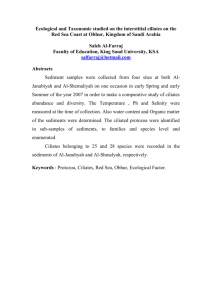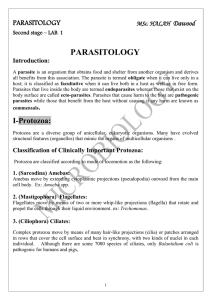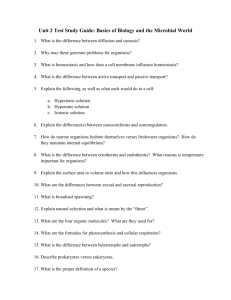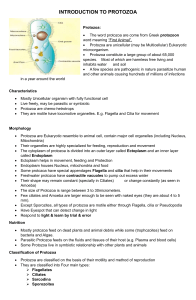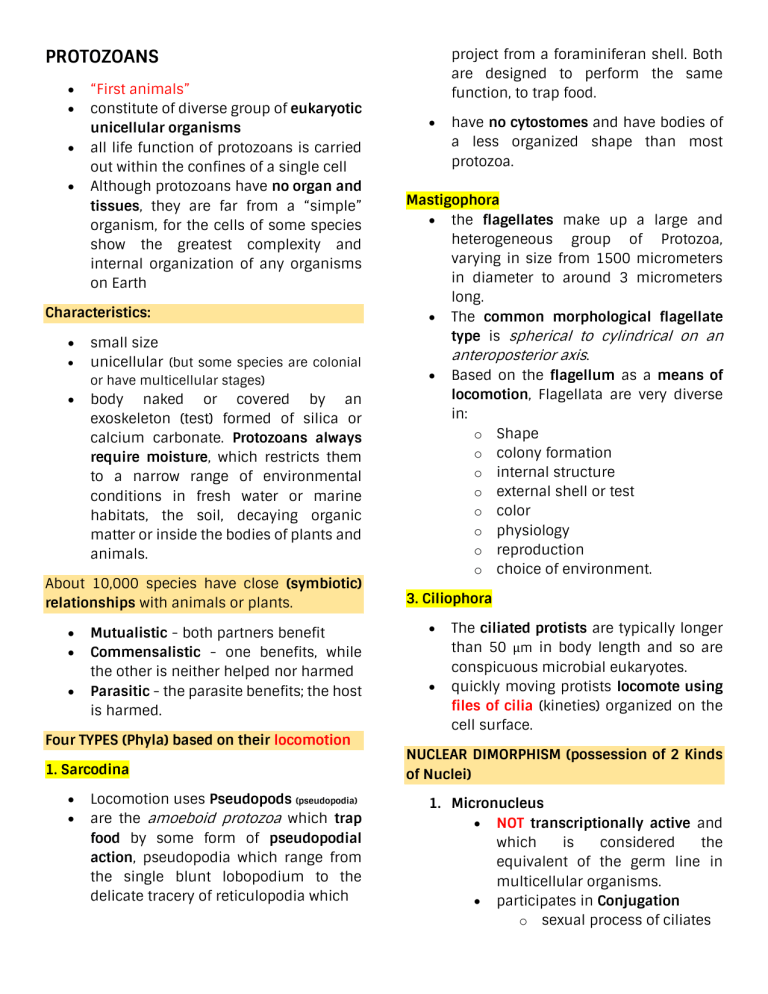
PROTOZOANS • • • • “First animals” constitute of diverse group of eukaryotic unicellular organisms all life function of protozoans is carried out within the confines of a single cell Although protozoans have no organ and tissues, they are far from a “simple” organism, for the cells of some species show the greatest complexity and internal organization of any organisms on Earth Characteristics: • • small size unicellular (but some species are colonial or have multicellular stages) • body naked or covered by an exoskeleton (test) formed of silica or calcium carbonate. Protozoans always require moisture, which restricts them to a narrow range of environmental conditions in fresh water or marine habitats, the soil, decaying organic matter or inside the bodies of plants and animals. About 10,000 species have close (symbiotic) relationships with animals or plants. • • • Mutualistic - both partners benefit Commensalistic - one benefits, while the other is neither helped nor harmed Parasitic - the parasite benefits; the host is harmed. Four TYPES (Phyla) based on their locomotion 1. Sarcodina • • Locomotion uses Pseudopods (pseudopodia) are the amoeboid protozoa which trap food by some form of pseudopodial action, pseudopodia which range from the single blunt lobopodium to the delicate tracery of reticulopodia which project from a foraminiferan shell. Both are designed to perform the same function, to trap food. • have no cytostomes and have bodies of a less organized shape than most protozoa. Mastigophora • the flagellates make up a large and heterogeneous group of Protozoa, varying in size from 1500 micrometers in diameter to around 3 micrometers long. • The common morphological flagellate type is spherical to cylindrical on an anteroposterior axis. • Based on the flagellum as a means of locomotion, Flagellata are very diverse in: o Shape o colony formation o internal structure o external shell or test o color o physiology o reproduction o choice of environment. 3. Ciliophora • • The ciliated protists are typically longer than 50 μm in body length and so are conspicuous microbial eukaryotes. quickly moving protists locomote using files of cilia (kineties) organized on the cell surface. NUCLEAR DIMORPHISM (possession of 2 Kinds of Nuclei) 1. Micronucleus • NOT transcriptionally active and which is considered the equivalent of the germ line in multicellular organisms. • participates in Conjugation o sexual process of ciliates o 2. 3rd Major feature to characterize this group They cause disease in a wide variety of animals from earthworms and rats to silkworms (the disease called pebrine) and fish. Macronucleus • Transcriptionally active and which is typically a developmental product of the amplification of the micronuclear or germ-line DNA. Malaria is easily the most important sporozoan disease, especially for humans. Malarian organism live primarily in the Blood cell CILIATES as large cells are the top predators or heterotrophs in microbial food webs when metazoans are absent. As heterotrophs, they feed upon bacteria, smaller protists, and even other ciliates in ecosystems from the poles to the tropics and from terrestrial soils to the sediments around deep-sea hydrothermal vents. Ciliates can also be symbionts of other organisms, ranging from commensals found in the stomachs of ruminants to parasites of fish. Ciliates, such as TETRAHYMENA AND PARAMECIUM, whose genomes have been sequenced, serve as model organisms for cell and molecular biology. 4. Sporozoa • • • • parasitic protozoans that lack locomotor organs: o no cilia o no flagella o no pseudopods. Intracellular parasites They usually pass from host to host in protective capsules called spores which enclose zygotes or juvenile states; however, those species that are transmitted by blood-sucking vectors, like mosquitoes, lack true spores. Very large and diverse class with at least four subclasses and many thousands of species. Coccidiosis, which afflicts poultry and cattle is second. Some sporozoans, like the malarial organism, live Coccidia, live in the Epithelial cells lining the intestine. Other pathogenic species: • • • Trypanosoma Protozoa Giardia Protozoa Plasmodium Protozoa
